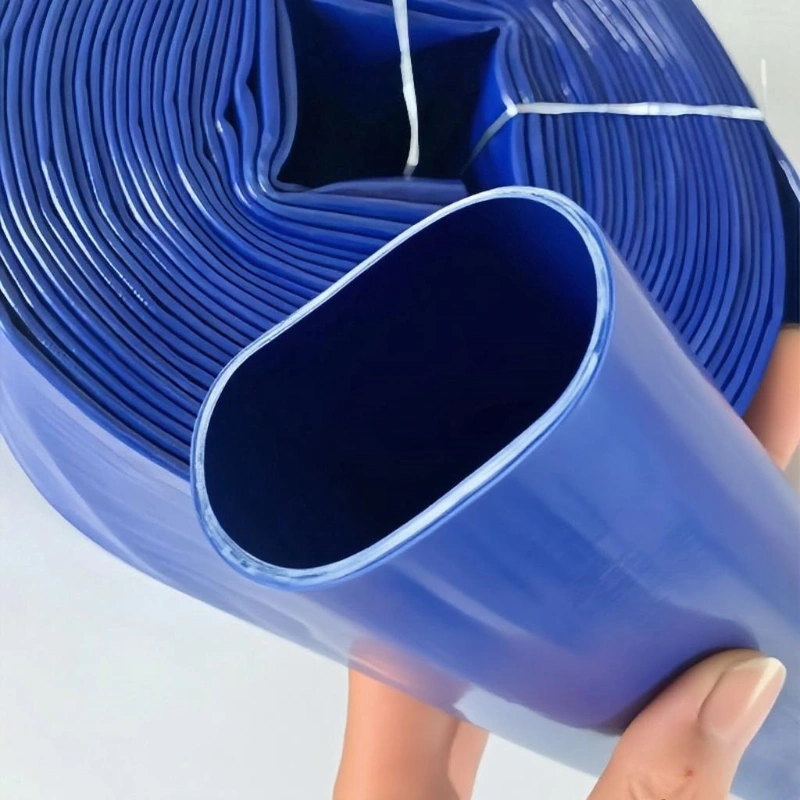A 3-inch lay-flat hose is the workhorse of water transfer. It sits quietly rolled up like a sleeping python until the pump starts, and then it delivers thousands of liters of water with surprising efficiency. For agriculture, construction, mining, and flood control, this hose size strikes a balance between flow rate, handling, and cost.
What a 3-Inch Lay Flat Hose Actually Is
It’s a lightweight hose made from PVC or TPU with woven polyester reinforcement.
The magic of “lay-flat” is simple physics: once water pressure drops, the hose collapses into a flat strip for easy storage.
Typical industrial specs:
Inside diameter: 76 mm (3 inches)
Working pressure: 45–150 PSI (3–10 bar) depending on grade
Burst pressure: Usually 3× working pressure
Flow rate capacity: 300–350 gallons/min (1130–1325 L/min)
Standard lengths: 50 ft, 100 ft, 30 m, and 50 m rolls
Weight: 0.25–0.55 kg per meter depending on material
These numbers may look dry, but they determine whether the hose survives a season or folds under the heat of a high-pressure pump.
Where a 3 Inch Lay Flat Hose Is Used
The real beauty is how versatile it is.
Agriculture
Farmers use it for:
Pumping water from rivers or reservoirs
Drip and sprinkler system feeding
Seasonal water transfer during dry months
A 3-inch hose moves up to 79,000 liters per hour, which is perfect for orchards, vegetable farms, and palm plantations.
Construction & Mining
Contractors depend on it for:
Dewatering foundations
Removing groundwater from excavations
Pumping slurry or sediment-laden water
In rocky or muddy environments, choosing a hose with TPU and extra-thick outer walls dramatically improves lifespan.
Emergency & Flood Control
Municipalities love 3-inch hoses because:
They pair well with portable diesel pumps
They can be deployed by two people
They fill or empty temporary tanks rapidly
During floods, a pump-and-hose team can move over 1,000 m³ of water in a 12-hour shift.
PVC vs TPU: Which Material Performs Better?
PVC Lay Flat Hose
Cost-effective
Good for general purpose
Working pressure: 45–80 PSI
Lifespan: 1–2 seasons under moderate use
Best for farms, temporary projects, and clean water transfer.
TPU Lay Flat Hose
Abrasion resistant
Handles hot water
Working pressure: 100–150 PSI
Lifespan: 3–5 years with proper storage
Best for mining, construction, industrial pumping, and fire services.
The rule of thumb:
If the ground is kind, PVC is fine. If the ground fights back, TPU wins.
How to Choose the Right 3 Inch Lay Flat Hose
A few variables keep the decision grounded:
Pressure rating
Match hose pressure to pump output.
If your pump delivers 90 PSI, choose a 100–120 PSI hose.Length
Long hose = more friction = less flow.
A 30-meter hose loses about 8–12% pressure; a 50-meter hose loses 15–20%.Couplings
Aluminum camlocks are standard.
Stainless steel is overkill unless pumping chemicals.Wall thickness
Thicker walls handle rocks and heavy dragging far better.Storage temperature
PVC becomes stiff below 0°C. TPU stays flexible even at –40°C.
Real-World Usage Tips (Based on Field Experience)
1. Always unroll fully before pumping
Partially coiled hoses create kinks.
A kinked hose can spike pressure by 30–40%, leading to bursts.
2. Avoid dragging the hose when full
Dragging a charged hose scrapes the outer layer.
On construction sites, this is a common reason hoses die early.
3. Use strain relief at the pump connection
A tied rope or clamp prevents the hose from pulling loose when water surges.
4. If pumping sediment, flush after every use
Sediment acts like sandpaper.
Leaving muddy water inside accelerates wear.
5. Store dry and out of the sun
UV light is PVC’s secret enemy.
Good storage can extend lifespan by 40–60%.
Cost of 3 Inch Lay Flat Hose
Prices vary by material and pressure rating.
Typical factory-direct pricing in 2025:
PVC 3" hose (60 PSI): USD 0.80–1.20 per meter
PVC heavy duty (90 PSI): USD 1.20–1.80 per meter
TPU 3" hose (150 PSI): USD 4.00–7.50 per meter
A 30-meter roll might cost:
PVC: USD 30–55
TPU: USD 120–220
If you're outfitting a farm or renting equipment, these numbers help you avoid overpaying.
Common Mistakes (And How to Avoid Them)
Using a hose rated below pump pressure
This is the fastest route to watching your hose explode like a water balloon.
Running the hose over sharp ground
A single sharp rock can cut through PVC.
Always clear a path or lay a tarp.
Leaving hose full after use
Water sitting for weeks becomes moldy, smelly, and degrades inner walls.
Not checking couplings
Loose camlocks leak up to 10% of flow rate—a silent profit killer.
Conclusion
A 3-inch lay-flat hose is simple but crucial—almost every industry touches it at some point. Whether you’re moving irrigation water, draining a muddy foundation, or clearing floodwater, choosing the right hose means balancing pressure, material, and real-world handling.
When durability matters, TPU earns its keep. When budgets are tight and conditions mild, PVC still does its job admirably. And with proper storage and careful ground handling, the humble hose lasts far longer than most expect.

